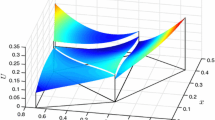Abstract
In the present investigation, we demonstrate the capabilities of the discontinuous Galerkin spectral element method for high order accuracy computation of gas dynamics. The internal flow field of a natural gas injector for bivalent combustion engines is investigated under its operating conditions. The simulations of the flow field and the aeroacoustic noise emissions were in a good agreement with the experimental data. We tested several shock-capturing techniques for the discontinuous Galerkin scheme. Based on the validated framework, we analyzed the development of the supersonic jets during different opening procedures of a compressed natural gas injector. The results suggest that a more gradual injector opening decreases the noise emission.
Similar content being viewed by others
References
C. K. Tam, N. N. Pastouchenko, and R. H. Schlinker, “Noise source distribution in supersonic jets”, Journal of Sound and Vibration, Vol. 291, no. 1, pp. 192–201, 2006.
H. Tanna, “An experimental study of jet noise part ii: Shock associated noise”, Journal of Sound and Vibra tion, Vol. 50, no. 3, pp. 429–444, 1977.
C. K. Tam, “Supersonic jet noise”, Annual Review of Fluid Mechanics, Vol. 27, no. 1, pp. 17–43, 1995.
G. Raman, “Supersonic jet screech: half-century from Powell to the present”, Journal of Sound and Vibration, Vol. 225, no. 3, pp. 543–571, 1999.
D. Munday, E. Gutmark, J. Liu, and K. Kailasanath, “Flow structure and acoustics of supersonic jets from conical convergent-divergent nozzles”, Physics of Fluids (1994-present), Vol. 23, no. 11, p. 116102, 2011.
S. Pirozzoli, “Numerical methods for high-speed flows”, Annual Review of Fluid Mechanics, Vol. 43, pp. 163–194, 2011.
T. White and B. Milton, “Shock wave calibration of under-expanded natural gas fuel jets”, Shock Waves, Vol. 18, no. 5, pp. 353–364, 2008.
V. Vuorinen, J. Yu, S. Tirunagari, O. Kaario, M. Larmi, C. Duwig, and B. Boersma, “Large-eddy simulation of highly underexpanded transient gas jets”, Physics of Fluids (1994-present), Vol. 25, no. 1, p. 016101, 2013.
O. Schönrock, Numerical prediction of flow induced noise in free jets of high Mach numbers. PhD thesis, Faculty of Aerospace Engineering and Geodesy of the Universit at Stuttgart, 2009.
T. Kraus, F. Hindenlang, D. F. Harlacher, C.-D. Munz, and S. Roller, “Direct aeroacoustic simulation of near field noise during a gas injection process with a discontinuous Galerkin approach,” 18th AIAA/CEAS Aeroacoustics Conference (33rd AIAA Aeroacoustics Conference). Colorado Springs, CO, 2012.
A. Schmidt, “Experimentelle Untersuchung einer Gasströmung durch ein CNG-Injektorventil mittels Particle-Image-Velocimetry (PIV),” Master’s thesis, Institute of Mechanics of the University of Kassel, 2012.
A. D. Beck, T. Bolemann, D. Flad, H. Frank, G. J. Gassner, F. Hindenlang, and C.-D. Munz, “Highorder discontinuous Galerkin spectral element methods for transitional and turbulent flow simulations”, International Journal for Numerical Methods in Fluids, Vol. 76, no. 8, pp. 522–548, 2014.
C. Altmann, A. D. Beck, F. Hindenlang, M. Staudenmaier, G. J. Gassner, and C.-D. Munz, “An efficient high performance parallelization of a discontinuous Galerkin spectral element method”, Facing the Multicore-Challenge III, Vol. 7686, pp. 37–47, 2013.
C. de Wiart and K. Hillewaert, “Development and validation of a massively parallel high-order solver for DNS and LES of industrial flows,” in IDIHOM: Industrialization of High-Order Methods -A Top-Down Approach, Springer International Publishing, Berlin, Heidelberg, 2015.
F. Hindenlang, G. Gassner, C. Altmann, A. Beck, M. Staudenmaier, and C.-D. Munz, “Explicit discontinuous Galerkin methods for unsteady problems”, Computers & Fluids, Vol. 61, pp. 86–93, 2012.
D. A. Kopriva, Implementing Spectral Methods for Partial Differential Equations: Algorithms for Scientists and Engineers. Springer Publishing Company, Inc., Berlin, Heidelberg, 1st ed., 2009.
F. Bassi and S. Rebay, “A high-order accurate discontinuous finite element method for the numerical solution of the compressible Navier-Stokes equations”, Journal of Computational Physics, Vol. 131, no. 2, pp. 267–279, 1997.
E. F. Toro, Riemann Solvers and Numerical Methods for Fluid Dynamics. Springer, Berlin, Heidelberg, 2009.
D. G. Flad, H. M. Frank, A. D. Beck, and C.-D. Munz, “A discontinuous Galerkin spectral element method for the direct numerical simulation of aeroacoustics,” In Proceedings of the American Institute of Aeronautics and Astronautics, 2014.
C. Pruett, B. Thomas, C. Grosch, and T. Gatski, “A temporal approximate deconvolution model for largeeddy simulation”, Physics of Fluids, Vol. 18, no. 2, p. 8104, 2006.
F. Bassi and S. Rebay, “High-order accurate discontinuous finite element solution of the 2d Euler equations”, Journal of Computational Physics, Vol. 138, no. 2, pp. 251–285, 1997.
F. Hindenlang, G. Gassner, T. Bolemann, and C.-D. Munz, “Unstructured high order grids and their application in discontinuous Galerkin methods,” In Proceedings of the V European Conference on Computational Fluid Dynamics ECCOMAS CFD 2010, Lisbon, Portugal, 2010.
P.-O. Persson and J. Peraire, “Sub-cell shock capturing for discontinuous Galerkin methods”, In Proceedings of the American Institute of Aeronautics and Astronautics, Vol. 112, 2006.
F. Ducros, V. Ferrand, F. Nicoud, C. Weber, D. Darracq, C. Gacherieu, and T. Poinsot, “Large-eddy simulation of the shock/turbulence interaction”, Journal of Computational Physics, Vol. 152, no. 2, pp. 517–549, 1999.
M. Sonntag and C.-D. Munz, “Shock capturing for discontinuous Galerkin methods using finite volume subcells,” in Finite Volumes for Complex Applications VIIElliptic, Parabolic and Hyperbolic Problems, vol. 78 of Springer Proceedings in Mathematics & Statistics, pp. 945–953, Springer International Publishing, Berlin, Heidelberg, 2014.
G. Gassner and A. Beck, “On the accuracy of highorder discretizations for underresolved turbulence simulations”, Theoretical and Computational Fluid Dynamics, Vol. 27, no. 3–4, pp. 221–237, 2013.
I. Wygnanski and H. Fiedler, “Some measurements in the self-preserving jet”, Journal of Fluid Mechanics, Vol. 38, pp. 577–612, 1969.
T. Alheit, “Preassure peak at high frequencies for natural gas injector,” 2015. private communication.
Author information
Authors and Affiliations
Rights and permissions
About this article
Cite this article
Hempert, F., Hoffmann, M., Iben, U. et al. On the simulation of industrial gas dynamic applications with the discontinuous Galerkin spectral element method. J. Therm. Sci. 25, 250–257 (2016). https://doi.org/10.1007/s11630-016-0857-8
Received:
Published:
Issue Date:
DOI: https://doi.org/10.1007/s11630-016-0857-8




